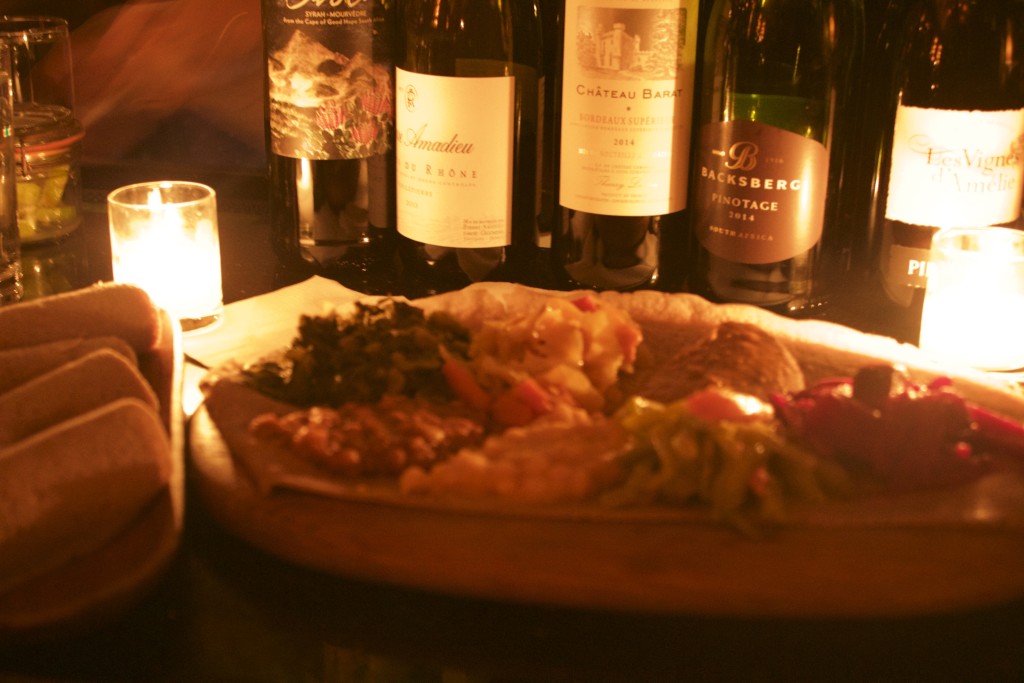
The vegetarian combination platter at Injera. Customers can have the traditional Ethiopian bread made gluten-free, if they call two days in advance. Photo: JoVona Taylor.
Located across the street from Abingdon Square Park, in a West Village neighborhood full of trendy eateries, Injera is a two-year-old restaurant owned by Roman Keflay, an Ethiopian émigré, and her French husband, Pierre Casaux. It is named after the sponge-like, traditional Ethiopian bread that doubles as cutlery, used to scoop up food by hand. The couple serves authentic Ethiopian dishes against a backdrop of candlelight, attentive service and tunes from Erykah Badu to Billie Holiday.
The Ethiopian population in New York City was estimated at 4,870 in 2013, according to census data, and Yelp.com lists 18 Ethiopian restaurants in the city. Keflay noted that most of the Ethiopian restaurants she has visited stick with the familiar, from food to décor to music. The food at Injera follows the trend of authenticity with recipes from Keflay’s late mother, who trained chef Julio Ramirez— a native of Mexico — for four months before the January 2014 opening. The atmosphere has more of a modern appeal. Keflay, a former fashion designer, sits at the full bar near the kitchen and admits that some Ethiopian visitors have complained about the non-traditional elements of her restaurant.
“The beauty of being in America is that you have choices,” Keflay says. “If an Ethiopian person is into super-super traditional decor and music, they can go to another place where they provide them with that.” She jokingly deflects the criticisms by pointing out the Ethiopian Orthodox church cross that she keeps near the cash register.
Being in the competitive West Village serving an understated ethnic cuisine is a challenge bigger than the song and art selections, in terms of the restaurant’s overall success.
“This was a gamble, but a that gamble that paid off,” Keflay says of her choice to open in the neighborhood that she calls an ethnic cuisine desert.
Only one hour after the 5 p.m. dinner opening on a Tuesday night, four of the seven tables are full. Keflay says that the clientele is as unpredictable as the playlist with diverse customers drawn to the menu, which offers dishes from $16 to $65.
Coming from Ethiopia to America 28 years ago, Keflay, 54, does not seem to have an ounce of the timidity she says she finds among many others from her home country. She greets every customer with a big smile outlined by red lipstick, and some get an additional hug, smooch or gursha — an Ethiopian custom of feeding someone to signify friendship.
Casaux, 50, came to America from France 20 years ago and worked various restaurant jobs until 1997, when he opened the Mediterranean restaurant L’orange Bleue in SoHo. It closed in 2011, but by then he had met Keflay, who lived nearby and often ate at the restaurant. The couple opened Injera a year after they married.
“I think it’s good, not saying it’s easy, but it’s good,” he said of working with his lively wife, who balances out his laid-back demeanor.
Casaux said that running Injera has been a different experience from L’orange Bleue, which was a bigger operation with more of a nightlife scene.
“It was a different time, too,” he added. “When I closed the place, the social media was basically nonexistent. For many years, there was no such thing as Yelp or Facebook, so learning that has been new, too.”
Casaux brought the 43-year-old Ramirez, who had been the chef at L’orange Bleue for 12 years, to Injera, confident that he could master Ethiopian cuisine. Keflay brought her mother from Ethiopia for reinforcements.
“She taught me everything,” said Ramirez, who worked his way up from bus boy to head chef over his 24-year stint in the restaurant industry. “Learning professionally is not the same. One is like original, homemade, and the other is more commercial.”
Ramirez cooks a number of ethnic dishes, from Moroccan to French, but says that Ethiopian is one of his favorites, citing its organic, vegetable-based dishes and similarities in preparation to the Mexican dishes he grew up with. His days usually start at noon, when he comes in to chop vegetables and prepare the injera, which is made of teff flour shipped from Ethiopia that must be fermented for four to five days.
Ramirez’s 22-year old son, Julio Govani Ramirez Jr., also works as a server at Injera a few days a week while studying psychology. His first job as a teenager was in Casaux’s previous restaurant.
“They’re like second parents to me,” Ramirez Jr. said of Casaux and Keflay, as he served two customers at the bar area on a Friday night.
Soon every seat is filled, and Keflay, Casaux and Ramirez Jr. attend to the many customers on the typical busy day of the week. The two patrons at the bar are happy to get a seat, since they have to travel back to the Bronx and Queens after their meals. Ivana Cendric, 27, and Melissa Valencia, 29, have never eaten Ethiopian food, and decided on Injera for their first time.
A platter of stewed vegetables and spices arrive — shiro, atakilt, kik alicha, gomen, kaye siir, fasolia and misir wot, all on top of a thin layer of injera.They agree that it looks good and begin using the bread to scoop up mouthfuls of food.
“The restaurant business is difficult because it’s not easy to get a good team to work,” Keflay says. “But, you get to meet a lot of people, and you get to see people happy, and it makes you happy.”
Tags: Ethiopian restaurant, ethnic cuisine, Injera, Manhattan, NEW YORK CITY, West Village
Your Comments